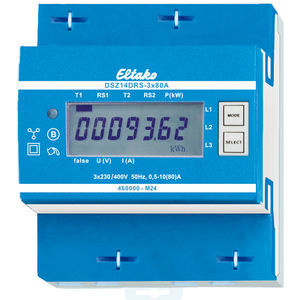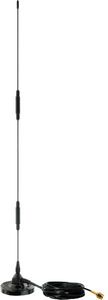
Single-phase electrical energy meter F2L14DIN rail50 Hz

Add to favorites
Compare this product
Characteristics
- Type
- single-phase
- Assembly
- DIN rail
- Other characteristics
- 50 Hz
- Voltage
250 V
- Primary current
16 A
Description
2-speed fan relay, 1+1 NO contacts potential free 16A/250V AC, with DX technology. Bidirectional. Only 0.1 watt standby loss. Modular device for DIN-EN 60715 TH35 rail mounting. 1 module = 18mm wide, 58mm deep. Connection to the Eltako-RS485 bus. Bus cross wiring and power supply with jumper. Patented Eltako Duplex technology allows you to switch normally potential free contacts in zero passage switching when 230V A/C voltage 50Hz is switched. This drastically reduces wear. To achieve this, simply connect the N conductor to the terminal (N1) and L to 1(L) and/or N to (N2) and L to 3(L). This results in an additional standby consumption of only 0.1 watt. If supply voltage fails, the switching state is retained. When supply voltage is restored, the device is switched off in defined mode. This fan relay evaluates the information of up to 23 passive sensors, e.g. wireless pushbuttons, window/door contacts, window handle sensors FFG7B-rw or wireless transmitter modules. Active sensors for CO2, air quality, humidity and temperature are also evaluated. Several active sensors can be linked by the PCT14 PC Tool. When the two contacts are switched in parallel, the 2-speed actuator for 2 fan speeds becomes an actuator for one fan. The middle rotary switch must be set to position LRN for teach-in. Set the required operating mode when the fan actuator is in operation. During the teach-in process, adjust the upper rotary switch to set the sensor type.
Catalogs
No catalogs are available for this product.
See all of Eltako Electronics‘s catalogsOther Eltako Electronics products
SERIES 14 – RS485 BUS RAIL-MOUNTED DEVICES FOR THE CENTRALISED WIRELESS BUILDING INSTALLATION
Related Searches
- Digital electrical energy meter
- DIN rail electrical energy meter
- Three-phase electrical energy meter
- Electrical energy meter with LCD display
- Single-phase electrical energy meter
- RS-485 electrical energy meter
- Motion detector
- Wireless detector
- 50 Hz electrical energy meter
- Electric energy meter with built-in communication
- Analog signal transmitter
- Brightness detector
- Wireless electric energy meter
- Wireless analog signal transmitter
*Prices are pre-tax. They exclude delivery charges and customs duties and do not include additional charges for installation or activation options. Prices are indicative only and may vary by country, with changes to the cost of raw materials and exchange rates.








